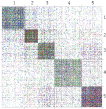Protein Interaction Networks - More than Mere Modules
Stefan Pinkert,
Jörg Schultz
&
Jörg Reichardt
Abstract
It is widely believed that the modular organization of cellular function is reflected in a modular structure of molecular networks. A common view is that a "module" in a network is a cohesively linked group of nodes, densely connected internally and sparsely interacting with the rest of the network. Many algorithms try to identify functional modules in protein-interaction networks (PIN) by searching for such cohesive groups of proteins.
Here, we present an alternative approach independent of any prior definition of what actually constitutes a "module". In a self-consitent manner, proteins are grouped into "functional roles", if they interact in similar ways with other proteins according to their functional roles. Such grouping may well result in cohesive modules again, but only if the network structure actually supports this.
We applied our method to the PIN from the Human Protein Reference Database and found that a representation of the network in terms of cohesive modules, at least on a global scale, does not optimally represent the network's structure because it focusses on finding indepen- dent groups of proteins. In contrast, a decomposition into functional roles is able to depict the structure much better as it also takes into account the interdependencies between roles and even allows groupings based on the absence of interactions between proteins in the same functional role, as is the case for transmembrane proteins, which could never be recognized as a cohesive group of nodes in a PIN.
When mapping experimental methods onto the groups, we identified profound differences in the coverage suggesting that our method is able to capture experimental bias in the data, too. For example yeast-two-hybrid data were highly overrepresented in one particular group.
Thus, there is more structure in protein-interaction networks than cohesive modules alone and we believe this finding can significantly improve automated function prediction algorithms in the future.
Supplemental Material: Cluster with GO Ontologies
